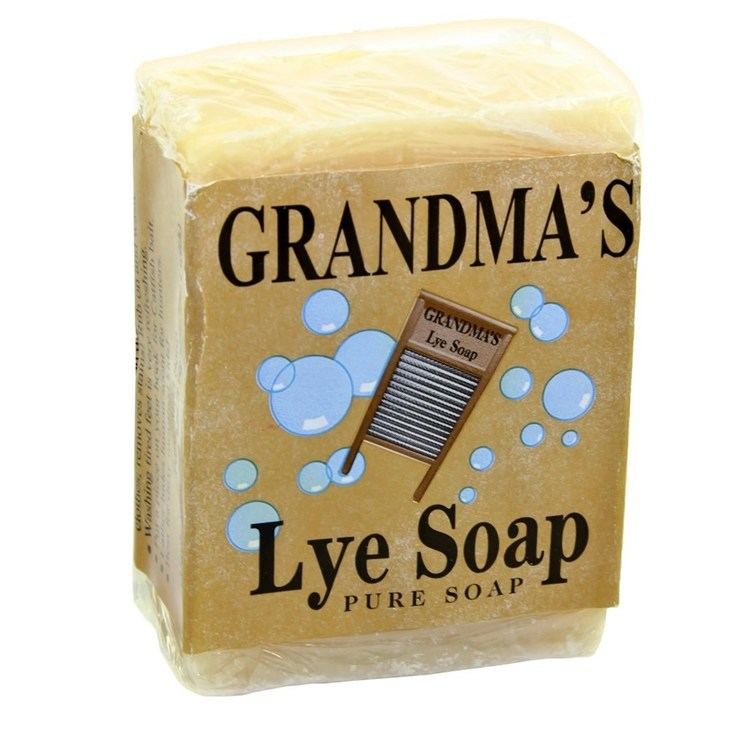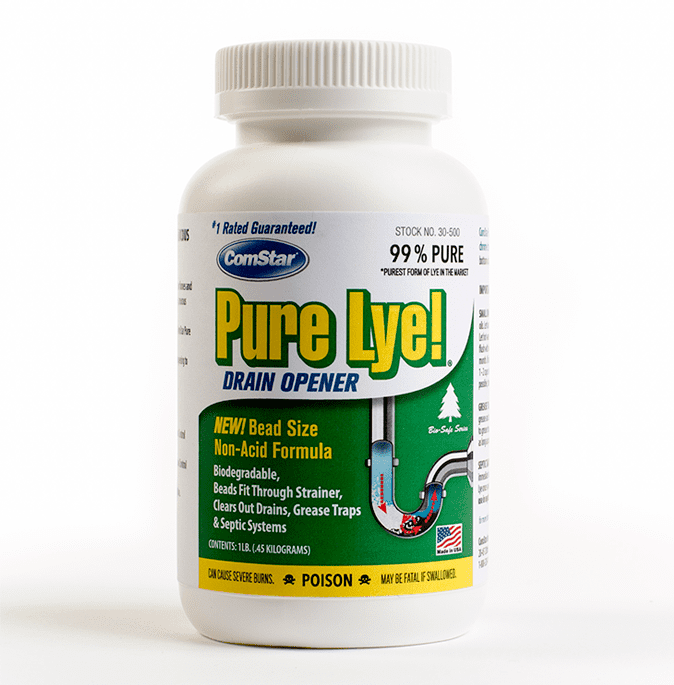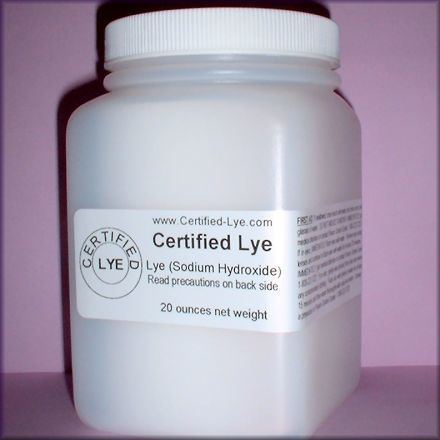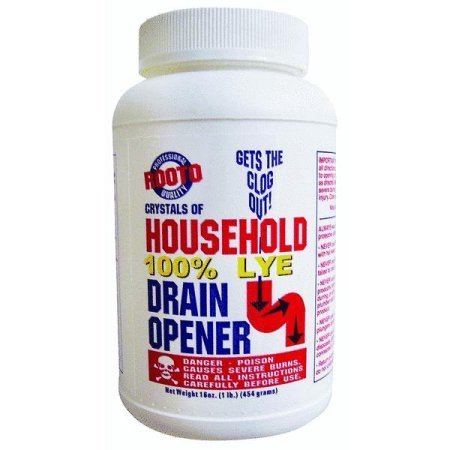 | ||
A lye is a liquid metal hydroxide obtained by leaching ashes (containing largely potassium carbonate or "potash"), or a strong alkali which is highly soluble in water producing caustic basic solutions. "Lye" is commonly an alternative name of sodium hydroxide (NaOH) or historically potassium hydroxide (KOH), though the term "lye" refers to any member of a broad range of metal hydroxides.
Contents
- Making sodium hydroxide lye from salt
- Food uses
- Soap making
- Household uses
- Tissue digestion
- Fungus identification
- First aid
- Protection
- Storage
- Hazardous reactions
- References

Today, lye is commercially manufactured using a membrane cell chloralkali process. It is one of the highest-volume industrial chemicals with worldwide annual production of 45 million tons in 1998. It is supplied in various forms such as flakes, pellets, microbeads, coarse powder or a solution.
Making sodium hydroxide lye from salt
Food uses

Lyes are used to cure many types of food, including the traditional Nordic lutefisk, olives (making them less bitter), canned mandarin oranges, hominy, lye rolls, century eggs, and pretzels. They are also used as a tenderizer in the crust of baked Cantonese moon cakes, in "zongzi" (glutinous rice dumplings wrapped in bamboo leaves), in chewy southern Chinese noodles popular in Hong Kong and southern China, and in Japanese ramen noodles.They are also used in kutsinta, a type of rice cake from the Philippines.

In the United States, food-grade lye must meet the requirements outlined in the Food Chemicals Codex (FCC), as prescribed by the U.S. Food and Drug Administration (FDA). Lower grades of lye which are unsuitable for use in food preparation are commonly used as drain de-cloggers and oven cleaners.
Soap making

Lye in the form of both sodium hydroxide and potassium hydroxide is used in making soap. Sodium hydroxide is often used to make solid soap, while potassium hydroxide is used to make liquid soap. Potassium hydroxide soaps are softer and more easily dissolved in water than sodium hydroxide soaps. Sodium hydroxide and potassium hydroxide are not interchangeable in either the proportions required or the properties produced in making soaps.

The "cold process" method is often used to make soap from lye. The lye is mixed with water, and then base oils, butters and fragrances are added. The gradual chemical reaction between the lye and the fats eventually produces a solid soap.
"Hot process" soap making also uses lye as the main ingredient. Lye is added to water, cooled for a few minutes and then added to oils and butters. The lye is then cooked over a period of time (1–2 hours), typically in a slow cooker, and then placed into a mold. This method is much quicker than cold process, as it takes several weeks to complete.
The ancient use of lye for soap-making and as a detergent is the origin of the English word, deriving from Proto-Germanic *laugo and ultimately from the Proto-Indo-European root *leue-, "to wash." Relatives in other Germanic languages, besides their words for lye, include the Scandinavian languages' words for Saturday (laugardagur, lördag, lørdag), meaning "washing day".
Household uses
Lyes are also valued for their cleaning effects. Sodium hydroxide is commonly the major constituent in commercial and industrial oven cleaners and clogged drain openers, due to its grease-dissolving abilities. Lyes decompose greases via alkaline ester hydrolysis, yielding water-soluble residues that are easily removed by rinsing.
Tissue digestion
Sodium or potassium hydroxide can be used to digest tissues of animal carcasses or deceased humans. Often referred to as alkaline hydrolysis, the process involves placing the carcass or body into a sealed chamber, adding a mixture of lye and water and the application of heat to accelerate the process. After several hours the chamber will contain a liquid with coffee-like appearance, and the only solid that remains are very fragile bone hulls of mostly calcium phosphate, which can be mechanically crushed to a fine powder with very little force. Sodium hydroxide is frequently used in the process of decomposing roadkill dumped in landfills by animal disposal contractors. Due to its low cost and availability, it has been used to dispose of corpses by criminals. Italian serial killer Leonarda Cianciulli used this chemical to turn dead bodies into soap. In Mexico, a man who worked for drug cartels admitted to having disposed of more than 300 bodies with it.
Fungus identification
A 3–10% solution of potassium hydroxide (KOH) gives a color change in some species of mushrooms:
See: Chemical test in mushroom identification
First aid
Sources recommend immediate removal of contaminated clothing/materials, gently brushing/wiping excess off of skin, and then flushing the area of exposure with running water for 15–60 minutes while contacting emergency services.
Protection
Personal protective equipment including safety glasses, chemical-resistant gloves, and adequate ventilation are required for the safe handling of lyes. When in proximity to a lye that is dissolving in an open container of water, the use of a vapor-resistant face mask is recommended. Adding lye to water too quickly can cause the solution to boil.
Storage
Solid lyes are deliquescents and have a strong affinity for air moisture. Solid lyes will deliquesce or dissolve when exposed to open air, absorbing a relatively large amount of water vapour. Accordingly, lyes are stored in air-tight plastic containers. Glass is not a good material to be used for storage as lyes are mildly corrosive to it. Similar to the case of other corrosives, the containers should be labeled to indicate the potential danger of the contents and stored away from children, pets, heat, and moisture.
Hazardous reactions
The majority of safety concerns with lye are also common with most corrosives, such as their potentially destructive effects on living tissues; examples are the skin, flesh, and the cornea. Solutions containing lyes can cause chemical burns, permanent injuries, scarring and blindness, immediately upon contact. Lyes may be harmful or even fatal if swallowed; ingestion can cause esophageal stricture. Moreover, the solvation of dry solid lyes is highly exothermic; the resulting heat may cause additional burns or ignite flammables.
The reaction between sodium hydroxide and a few metals is also hazardous. Aluminium reacts with lyes to produce hydrogen gas. Since hydrogen is flammable, mixing a large quantity of a lye such as sodium hydroxide with aluminum in a closed container is dangerous—especially when the system is at a high temperature, which speeds up the reaction. In addition to aluminum, lyes may also react with magnesium, zinc, tin, chromium, brass or bronze—producing hydrogen gas.
